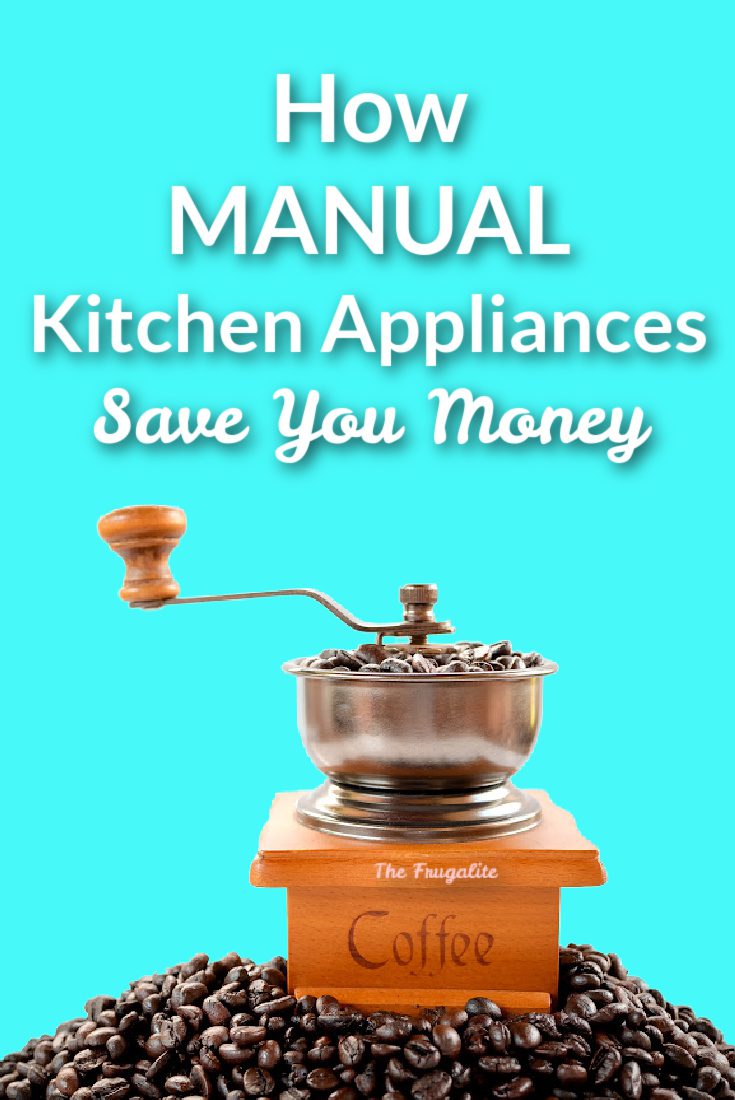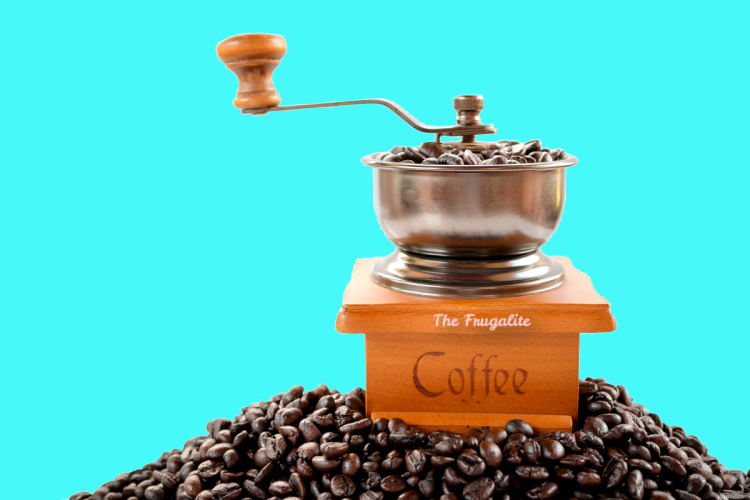(Psst: The FTC wants me to remind you that this website contains affiliate links. That means if you make a purchase from a link you click on, I might receive a small commission. This does not increase the price you’ll pay for that item nor does it decrease the awesomeness of the item. ~ Daisy)
Are off-grid, manual kitchen appliances more thrifty than electrically powered ones? In this article, I am going to make the argument that they have many benefits over electrical ones. What am I basing my opinions on? For five years, I lived completely off-grid in my tiny house on wheels (8 by 24 feet) without running water. During that time, I was designing and building my permanent eco-cabin on a foundation (18 by 24 feet). My off-grid system was minimal: only two standard panels powered my little house.
Especially in the winter, there was little electricity for any extras, unless I wanted to go out in the snow and start the generator. (No, didn’t feel like doing that unless required. In addition, the generator burns premium fuel – an expensive habit!) As a result, during those five years, I used only manual kitchen appliances.
I passed my occupancy inspection on my eco-cabin around six months ago and moved in immediately. My eco-cabin is designed to function well if the grid is down. However, I do have it connected to the grid right now. Regardless, I have still kept all of my off-grid appliances and use all of them regularly. I will discuss each one in turn and reflect on the benefits it offers, especially in relation to frugal living!
Hand-Crank Food Processor
I found my food processor in a local thrift shop as I was preparing to move off-grid. It likely cost me around $4.00 brand new. It holds around 2.5 cups of food in it and has a very sharp blade. Instead of an electric motor to run it, the lid has a handle on it and connects to a mechanism to turn the blade. If you hold the lid down, you can turn it very quickly (I call that high speed). Also, you also don’t have to crank forever to get the effect you want. Here’s a hand crank food processor you might like.
The main reason I bought this is to puree soups. I have pureed different kinds of soup using my food processor, including a green tomato and garlic soup and a cold minty cantaloupe soup. It works quite well. I don’t mind if the puree isn’t perfect. Some chunks are ok. For my purpose, this off-grid item is a great value. A three-cup Cuisinart food processor is around $78.00. In addition, I am not adding to my electricity bill with my own hand crank version. Win win! Save save!
Gave up the Bread Machine
At the time I went off-grid, I owned a bread machine. I gave it to my cousins. The tiny house didn’t have an oven, so I wasn’t planning on baking a lot of bread. It was an experiment to see if I could live well without an oven. When I made the move to my eco-cabin, I bought an off-grid gas range WITH an oven.
I am now my own bread machine – I occasionally make yeast bread and knead it myself. I also make pancakes to use as breakfast bread. Here are some great tips on creative bread substitutes you can use in a pinch. The average two-pound bread maker is around $110.00 new. They also run quite a long time as they make the bread (3-4 hours), so they use a fair amount of electricity. According to an off-grid resource, the average bread maker uses around 330 Watt-Hours to complete a loaf. In the winter, I bake my bread in my gas range, and it helps heat my eco-cabin. In addition, the baking time for my go-to bread recipe is only 30 minutes. So, I would say being my own bread maker is a winner in savings compared to buying an electric bread maker on all counts.
Hand-Operated Coffee Grinder
Every morning, I grind my coffee beans fresh in my hand grinder just before I make my coffee. The smell alone is delicious. My hand grinder is a stylish model with a stained wooden body and cute drawer where the ground coffee falls into. It cost less than $15.00 at my local thrift shop. I can set the grind on my hand grinder by adjusting a nut on top of where the handle attaches. An electric grinder where you can adjust the grind (a burr grinder) will set you back at least $78.00. Here’s an excellent quality, adjustable manual coffee grinder.
In addition, think about this: what if the power went out? Could you make coffee??? This is very important!!! No power, no problem for me: I just take my hand-ground coffee and put it in my French Press coffee maker. For more info on making a great cup of coffee, check this article out.
Camping Toaster
I like my toast pretty dark. When I first moved off-grid, I started using a camping toaster on my gas range. The toaster was like a metal stand with wires you could lean your bread on. You may have seen this kind of toaster before. The problem: it was taking forever to toast my bread! I just ripped off the wires and threw my bread on the metal base. Voila! Well toasted bread in no time. This camping toaster cost me a whopping $8.00. Even though I’m on the grid now, I still use it. Why not? It works, and a new toaster would cost me on average, around $50.00. In addition, my off-grid “toaster” will never wear out or break. Win…win….win! Save….save….save! These are very inexpensive to buy – check this one out.
The Matter in Hand: Manual Kitchen Appliances or Electrical???
Manual kitchen appliances offer savings both in initial cost and because they don’t need electricity to power them. Could you see yourself trying your hand with any of the off-grid appliances discussed here? Do you have one of your own you can share with us? Please tell us in the comments below.












26 thoughts on “How Manual Kitchen Appliances Save You Money”
Regarding the toaster, when I was in Europe going from AirBnB to AirBnB, hardly any were equipped with a toaster. Since I was living out of suitcases I wasn’t going to take up valuable luggage real estate with my own toaster. I asked a friend and he was really confused as to why we’d need an entire device for that. He said they just fry their bread on a skillet with some butter (which you’d be putting on it anyway.) It works wonderfully and only takes a couple of minutes. It’s kind of like making a grilled cheese minus the cheese. ?
So I’m not the only American who does this. If I use my toaster and microwave at the same time the power goes off to the whole house, so it’s just easier to find another way. When I move into my camper I won’t have a toaster and won’t miss it. Doing your toast this way tastes amazing. After you grill the first side try sprinkling some garlic salt and parmesan from the can on it for instant garlic toast, or some mixed cinnamon/sugar for cinnamon toast, before flipping it to do the other side. Especially the cinnamon sugar; the sugar caramelizes and you will not find a better, lower calorie substitute for a fast cinnamon bun breakfast.
Hi Mme. Homebody, You had me at carmelized. I will definitely be adding this to my cooking repertoire. I don’t buy baked goods, but I can see this would be a nice treat, especially with a good cup of tea. Many thanks for sharing!
Hi Daisy, Mmmmmm! What a fantastic idea. Who needs a toaster anymore?
I’ve done that and it works well!
I have been a manual girl for quite a while, never having bothered with a bread maker or food processor or Kitchenaid or anything like that. I occasionally use a toaster but can toast bread in a pan too. My most commonly used “food processor” is a really sharp knife. I do use a blender on occasion as well. Have an electric coffee grinder but have a hand crank one also. It’s also good for spices!
One tip for people who want to go more manual – better tools make the job much easier. For example, keeping your knives sharp, having good stable cutting boards, good strong bowls, and spoons that are stiff and sturdy helps a ton. My wooden paddle is very helpful in bread or cheesecake making because it’s sturdy enough to hold up, and I can get a good grip for maximum force. A whisk is very helpful also, and having bowls that are not only sturdy enough, but big enough, is a huge plus. A person can get by with very little in the way of electricity if they have the RIGHT tools, which don’t need to be expensive.
Another hand item which is good is a Foley Food Mill, which works to make apple sauce and mashed potatoes – it has a dull blade that scrapes across holes in the bottom of a pot, and you crank it around. It does an awesome job of retaining peelings and getting a fine mash.
Hi Redbranch, Wow! We have mathcing kitchens! I have a food mill, no idea of the brand, but it is invaluable for processing food. I bought mine at a local thrift shop. I never thought to use it for mashed….garlic mashed potatoes, here I come!
I haven’t owned an electric can opener in over 20 years. Own a manual ‘food processor’ and use it more often than the bulky huge electric one I own (esp now that it is just two of us. While I have an electric mixer, most often, use my whisk, potato masher. I do have a manual egg beater just in case. I am always on the lookout for manual backups at the thrift store and yard sales!
Hi Grammyprepper, You are clearly a prepared cook! I also enjoy getting my manual kitchen appliances the Frugalite way…at the thrift store and yard sales!
That was what I was about to say. I think it is one of the most important hand tools to have for grid down situations. Plus I am a
weirdo, I can’t seem to use electric can openers, the cans just fall off when I try so we only have hand openers. Note: if hand strength is a problem I bought my mother a big metal one off Amazon that is super easy to use. The industrial ones made for #10 cans that bolt to your table are also very easy to use.
Daisy, could you please put a link in for your 30 minute go to bread recipe? If you haven’t already. Please and thank you, Denise. I am planning to retire to an R.V. and live mostly off grid. Electric is getting more and more expensive and the power grid does go down. Thanks, Denise.
My favorites…an oxo egg beater, I have even made a small cake with it, a Rosle can opener, Hario coffee grinder, excellent knives from Rada, a flat ss grater, Borner mandoline, whisks, Pastry Pro Potato masher you can make pastry with too.
Hi Iowasue, Ah, excellent knives! I managed through total luck to find a complete set of Wustof knives at our local thrift shop. Just love them! I did not know you could make pastry with a potato masher and will keep that in mind. Thanks for sharing!
The pastry pro is actually a pastry blender from kitchen innovations that works as a potato masher too. Very handy and well made. They used to sell a larger one as a potato masher, I just bought the pastry blender and use it for mashing anything and making pie crust too.
Hi Iowasue, Thanks so much! As I’m not familiar with this product, it is so helpful for our readers to hear more about it. I admire your ability to make pie crust, by the way. I’m not quite there yet, although I make a delicious biscuit style pizza crust, if I do say so myself!
I have an OXO hand beater and it’s great. I have a French de Buyer mandoline which is quite versatile and makes lots of different cuts. I do recommend US made Cutco knives. Cutco offers free sharpening and a lifetime guarantee for their top shelf knives.
Hi Janis, Thank you for these great tips. My cousin has those Cutco knives. I was just using them the other day and they sure feel great in your hand!
A kitchen grain mill with hand cranking (or a hand cranking option alongside motor power) has some great advantages. Mine (a Country Living mill, a lot cheaper when I got it back in the Y2K era) can not only turn whatever grains I want into flour (one at a time, or in whatever combination blend I want), but with its optional bean auger it can turn dried beans into flour (there’s a whole art to cooking with bean flour). It can even turn any kind of nut into nut butter (as long as you don’t mind cleaning up the gooey mess that creates).
Back to the grains topic. Lots of people are either exploring or have already adopted a gluten-free diet as much as they can. That can be be difficult with grains since some of the best known grains are gluten-filled. The article below includes a list of 9 different gluten-free grains, which the grain mill I described above can turn any of those grains into flour for some great cooking and health benefits.
https://yurielkaim.com/gluten-free-grains-list/
I know there are several other brands of kitchen grain mill — each with their own set of features. I can only speak for what I have. I chose to replace the manual cranking radius on mine (a rotating hand grip on the outer rim of the same pulley that could be driven by a motorized belt) with a longer 14“ cranking radius via a homemade oak cranking arm I crafted. My experience was that the factory-supplied cranking radius for hand cranking via their pulley rim was too short and too exhausting, so with my homemade longer oak arm I could access all the many benefits I described above.
–Lewis
Hi Lewis, Your discussion of the kitchen grain mill is a wonderful addition to this article. The gluten free article was so interesting for me, even though I eat gluten. I would be interested to hear more sometime about the art of cooking with bean flour, if you have time! Many thanks for your useful and topical additons to articles through your comments!
Colette, regarding your question about bean flour cooking how-to: This 2011 edition is currently listed on Amazon:
Country Beans – How to cook dry beans in only 3 minutes! Paperback – December 1, 2011, by Rita Bingham
https://www.amazon.com/Country-Beans-cook-beans-minutes/dp/1882314115/ref=sr_1_2?crid=3NTM4KXT08XTY&keywords=country+beans+cookbook&qid=1638496954&s=books&sprefix=Country+Beans%2Caps%2C196&sr=1-2
My 1996 edition says 10 minutes on the cover. Inside it says “Country Beans introduces the use of bean flours in cream soups, sauces, gravies, as well as added to wheat flour to accomplish protein complimentation and emphasizes the use of nutritious, basic foods …”
Since both of those editions are well past the 6 months point after publisher’s release date, that makes them fair game in the US library system for a free interlibrary loan request (a system in place using the postal service since the late 1800s). That’s a near cost-free way to see if a book is worth acquiring from either the new or used market.
Hope this helps.
–Lewis
Hi Lewis, How fabulous! I found it so funny how the amount of time to cook the beans got smaller between 1996 and 2011? Is this a commentary on how time pressed our society is, I wonder? Will beans only take 1 minute to cook next year??? I think I am going to go ahead and buy this book. I had no idea about grinding beans this way. The main reason I DON’T eat more dried beans, including my own pinto bean harvest is the time they take to soak and cook. What a revelation! Thanks, Lewis!!!!
Ha ha ha, would you believe I actually forgot that there was such a thing as an electric can opener? I’ve never owned one and still haven’t figured out how to use one!
I have a culinary arts education and while we did have all the gizmos we lived and died by our hand tools:
-Obviously a good set of knives and a sharpener
-a hand whisk (less complicated than a eggbeater), and a potato masher
-a ricer, it is a sieve with a handle and a blade that pushes food through the sieve
-a hand or box grater, a small grater for zest and spices and a mandolin (a slicer not the musical instrument)
-a mortar and pestle for grinding spice
-a pasta machine (hand crank)
-a pastry blender and a bench scraper
I’m sure there are more but those are the first ones that came to mind. One thing you didn’t mention was time saving. Hand tool usually have fewer pieces so they are easier and quicker to get out, use and clean.
Hi Kay Mae, This is a great list from someone with a high level of know how! I love how you mention the time saving. I agree….by the time some people find these big machines in the back of their kitchen cupboards, find all the pieces and assemble them, and plug them in, most of us will already have the job done!
While the mention of manual can openers above was a good start there are some really helpful details worth mentioning. In the 8 minute video below, Hiram Cook explains 3 different types of manual can openers. At the 1:10 minute point he begins a useful can cross-section drawing of where each of those types makes its cut. The one of special interest here is his second type — the side cutter. As he shows, it leaves a smooth and non-dangerous edge on both the removed/reusable can lid and the top of the can itself.
https://www.youtube.com/watch?v=bzjc3gqVxIY
He doesn’t cover much detail about the many new uses for tin cans with freshly created reusable lids, such as to protect foods not completely used but worth saving and protecting against cross aroma contamination during in-fridge storage. He doesn’t mention leaving the product label on some cans and with the reusable lids using them for storage of small valuables in a way that wouldn’t attract attention. Replacing the product label with one of your own could also accommodate storage of small parts where security is less of a problem. A few cans sometimes may warp a little bit so a small weight to hold down the reusable lid can solve that warp problem.
Using larger cans with a side cutter would yield a good safety benefit when making impromptu camping cookware without the jagged edges that classic openers leave.
Hiram also only mentions the “Good Cook” manufacturer’s brand. While I strongly agree, I have also found excellent results in testing Farberware and T-Fal as well. In contrast, the Mainstay brand (a private label from Walmart) disintegrated on me after only a couple of months of testing. The molded hand cranking grip simply cracked into pieces (the quality had apparently been “Walmarted” out of it, as often happens).
I’ve never seen a motorized version of the side cutting can openers, so that keeps this discussion appropriate for this manual kitchen gadgets article.
Also the kitchenware product marketeers favor using labels like “safe” cutting and such — which keeps the real side cutting benefits more of a secret from shoppers. Thanks to Hiram Cook’s videos on side cutting manual can openers, I converted to using them several years ago most of the time for the many benefits that the standard can openers we all know and suffer with don’t have.
–Lewis
Hi Lewis, Thank you so much for another fabulous addition to our hand operated kitchen appliances! I really had given up hope of ever buying a decent can opener again. I will now keep my eye out for a side cutter. I love all the stealth options that become available to you with this cutter. By the way, ordered my bean book right away and it should be here soon. Absolutely not available in Canada that I could find, so had to order from America. Will be worth it! Can’t wait!